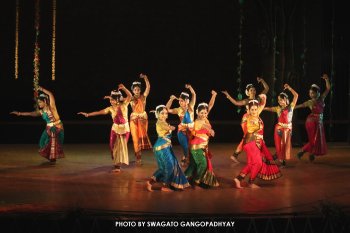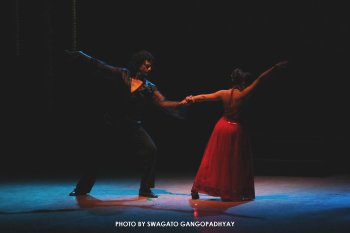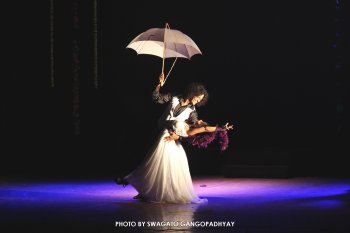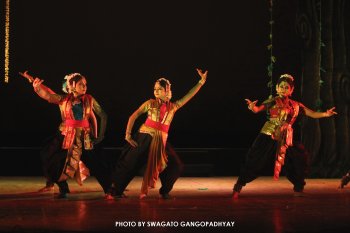
|   |

|   |
Paschime Rabi by Kalamandalam Kolkata - Nita Vidyarthi e-mail: drnitav@rediffmail.com Photos courtesy: Kalamandalam Kolkata July 25, 2013 Songs of Tagore based on Western melodies, Irish and Scottish tunes to be more specific, have been presented innumerable times with different permutations and combinations of their original versions but a choreographic presentation entitled Paschima Rabi (the Western Sun) on the theme by Guru Dr. Thankamani Kutty and Kalamandalam Kolkata at Rabindra Sadan as a part of Nikhl Banga Nababarsha Utsav Samity, is perhaps the first one. Somnath G. Kutty comes up always with interesting ideas and this one is no exception. Conceived and directed by him, the presentation incorporated western classical style of social dancing- ballroom dancing like The English Waltz ,Viennese Waltz, Foxtrot, and Latin American Salsa, Samba and contemporary styles side by side with Bharatanatyam and Kuchipudi for the Rabindrasangeet renditions.  Opening with a group presentation in Bharatanatyam set to the song “Alo Aaamar Alo,” the dancers of Kalamandalam proved their training and team work dancing joyously with this ever popular melodious number. Often heard numbers in Scottish tunes like “Phuley phuley dhole dhole” and “Purano sei diner katha” adapted from “Ye Banks and Braes” and “Auld Lang Syne” respectively were also included. The Western classical dance numbers were by Pedro S Kundu (who has also directed the western numbers) and Rony Roy and the Bharatanatyam and Kuchipudi ones by senior dancer Malabika Sen. Malabika, known for her abhinaya and singing talents, was naturally convincing as a lovelorn nayika in “Aha, aaji e Basantey” based on the Irish number “Go where the glory waits Thee.” Senior dancers Malabika Sen, Jhinuk Mukherjee, Jalsa Chandra, Moumita Chatterjee, Soumita Ghosh, Jayita Ghosh, Ashesha Sahalina Basu, Tania Dewanji and Sejuti Sengupta participated. 



Shinjini Acharya Majumdar has a background in Western vocals apart from her forte Rabindrasangeet. So naturally the original versions that she sang had the right modulation and articulation, seldom heard of those established singers who present both the versions simultaneously. Dancers trained at Kalamandalam have an authentic sense of the art and would naturally be a joy to watch. The music was directed by Debashish Saha, script by Shinjini Acharya Majumdar and the renowned singers Swagatalakshmi Dasgupta and Indrani Sen had lent their voice in the songs of Tagore. The presentation was on recorded music. |